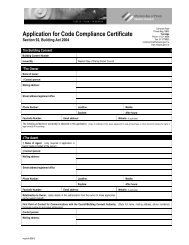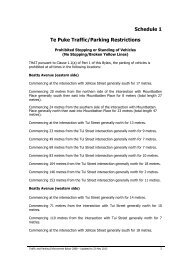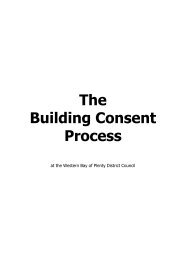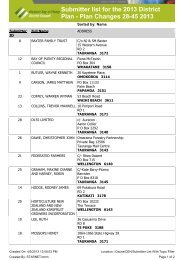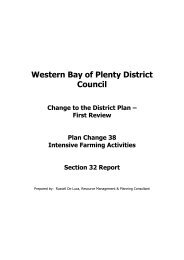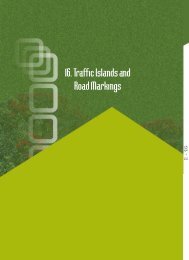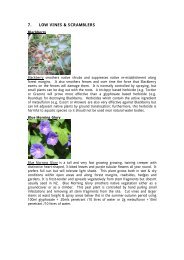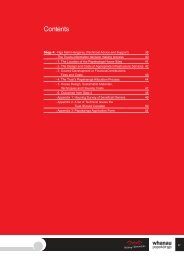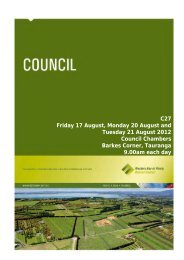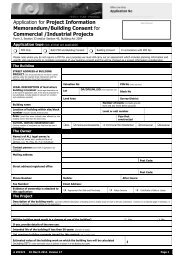Te Puna Plan - Western Bay of Plenty District Council
Te Puna Plan - Western Bay of Plenty District Council
Te Puna Plan - Western Bay of Plenty District Council
You also want an ePaper? Increase the reach of your titles
YUMPU automatically turns print PDFs into web optimized ePapers that Google loves.
High priority works are summarised below:<br />
Pedestrian facilities<br />
Borell Road footpath (Paparoa Road to school)<br />
Wallace Road footpath (full length)<br />
<strong>Te</strong> <strong>Puna</strong> Road (western side)<br />
Traffic Calming Treatment for <strong>Te</strong> <strong>Puna</strong> Road<br />
Carriageway Widening<br />
Borell Road to 9m<br />
<strong>Te</strong> <strong>Puna</strong> Road to 9m<br />
Waikaraka Drive East to 6m<br />
Wallace Road to 8m and kerb and channel<br />
Intersection Improvements<br />
Various locations for signage and safety markings<br />
Directional and Information Signs<br />
Lighting Improvements at<br />
Lindoch Avenue<br />
<strong>Te</strong> <strong>Puna</strong> Road<br />
Wallace Road/Matahiwi Road<br />
Stormwater Drainage<br />
Borell Road<br />
Matahiwi Road<br />
<strong>Plan</strong>tings <strong>of</strong> Street Trees<br />
As and when necessary<br />
Some four years have passed since the <strong>Plan</strong>’s adoption.<br />
It should be noted that this Streetscape Development <strong>Plan</strong> covered the area generally from State<br />
Highway 2 to the coast only.<br />
Rural intensification<br />
In addition to these planned proposals, the continued rural intensification <strong>of</strong> <strong>Te</strong> <strong>Puna</strong> has the potential<br />
to significantly impact on the environment through the cumulative effect <strong>of</strong> many small changes.<br />
Intensification <strong>of</strong> rural areas has been the subject <strong>of</strong> significant analysis and monitoring and good<br />
research is available.<br />
The SmartGrowth Rural Issues Report 3 identifies the implications <strong>of</strong> rural intensification, both positive<br />
and negative and these have been summarised below.<br />
Physical/Environmental Effects<br />
Rural intensification occurs gradually and the transition is <strong>of</strong>ten subtle. Physical effects include:<br />
<br />
<br />
<br />
<br />
increased pressure (traffic volume) on roads, with corresponding dust, noise and “wear and<br />
tear”<br />
increased pollution and energy use as result <strong>of</strong> increased traffic commuting to towns from<br />
lifestyle blocks<br />
fragmentation <strong>of</strong> productive farmland<br />
more houses, hard surfaces result in visual changes (largely irreversible) and stormwater run<strong>of</strong>f.<br />
<strong>Western</strong> <strong>Bay</strong> <strong>of</strong> <strong>Plenty</strong> <strong>District</strong> <strong>Council</strong> has conducted surveys <strong>of</strong> Attitudes to Rural Subdivision in<br />
1994, 1996, and 2000. Of relevance is that the two issues that emerge consistently in all these<br />
surveys at the top <strong>of</strong> the list <strong>of</strong> concerns are the effects on rural roads as a result <strong>of</strong> the increased<br />
traffic volumes and the fragmentation <strong>of</strong> highly productive rural land.<br />
Social Effects<br />
With rural intensification comes increasing rural population. Social effects include:<br />
<br />
<br />
<br />
<br />
<br />
increased school rolls<br />
better support for rural facilities<br />
less privacy as a result <strong>of</strong> the higher density <strong>of</strong> houses<br />
amenity conflicts and reverse sensitivity effects<br />
less community cohesion as a result <strong>of</strong> high turnover <strong>of</strong> lifestyle blocks.<br />
“Rural lifestylers” choose to live in the rural area mainly for amenity reasons (quiet, more space and<br />
privacy, attractive outlook) and their expectations can conflict with those more established rural<br />
dwellers who have located there for rural production values.<br />
Economic Effects<br />
The economic effects <strong>of</strong> rural intensification include:<br />
3 SmartGrowth – Rural Issues Report August 2002<br />
<strong>Te</strong> <strong>Puna</strong> Community <strong>Plan</strong> March 2007 Page 9



